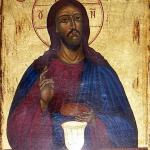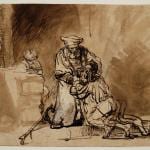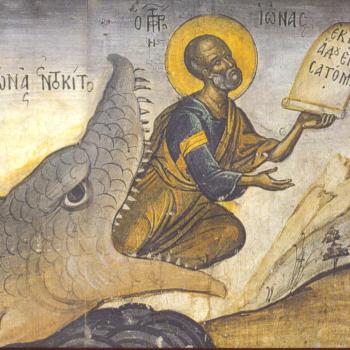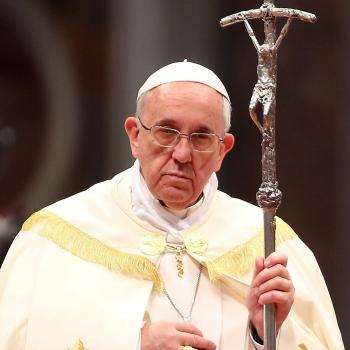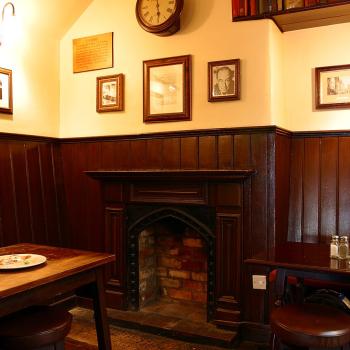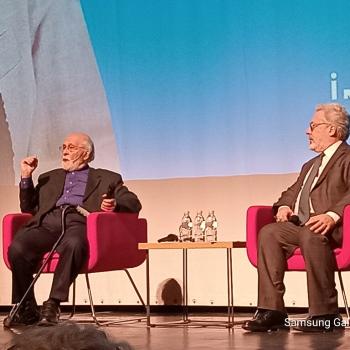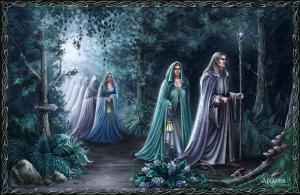
J.R.R. Tolkien, believing England did not possess a great myth of its own, wanted to write one for it. As with all such myths, he wanted it to be seen as semi-historical, that is, he wanted it to be seen as a possible pre-history for the world. In his writings and reflections, he treated it as if it were history, trying to reconcile what we know of recorded history with his myth, while recognizing that its mythic elements allowed it to transcend history and present universal truths in a way which only myths can do.
Tolkien was a devout Catholic, and many have noted various Catholic elements find themselves expressed in his works. On the other hand, many elements of his myth seem to contradict is Catholic beliefs. If Tolkien wanted his myth to be taken as a possible pre-history of the world (even if he knew it was not), it would seem that he would not want his Catholic faith to contradict what is found in his myth. Was there a way he could reconcile the two?
Tolkien could respond by pointing out that a part of the confusion lies in the difference between myth and theology. What is acceptable in myth, what is acceptable in poetry, is different from what one would expect from a systematic theological examination. Nonetheless, this does not mean Tolkien wasn’t challenged in trying to keep his mythic universe compatible with his Catholic faith. He was, but in many ways, he was following along the tradition of the great writers of myth and legends from the Middle Ages, because, like him, they assimilated non-Christian traditions and ideas into Christian stories (such as can be found in Beowulf or the legends surrounding King Arthur). Tolkien was trying to produce a great English myth which took into account not only his Christian faith but the pre-Christian and non-Christian tradition which helped create England.
There are certainly many places in his work in which the conflict between various non-Christian and Christian views shows up, but perhaps none make itself more apparent than the way reincarnation worked for Tolkien’s Elves. As Scull and Hammond’s Reader’s Guide explained, from the earliest stages of his writings, The Book of Lost Tales, Tolkien had established ways in which Elves which had been killed were able to be reborn in the world (with the caveat that Elves could and sometimes refused to do so):
From the writing of *The Book of Last Tales, for decades it was a firm tent of his mythology that the Elves who were killed might be reborn in their children, and this was still the case when Tolkien wrote *Laws and Customs among the Eldar in the late 1950s, in connection with the story of the Elf Miriel who ‘died’ and refused to reincarnate. [1]
Sometimes, Tolkien had the Valar make the new bodies for the Elves, but eventually he went forward with a more traditional approach in which the souls of the Elves, the fëa, made their own body for itself:
In Reincarnation of the Elves, as a second thought, Tolkien considered whether, rather than the Valar making the new body, the houseless fëa might be able to rebuild its body from memory. In the very late writings it is clear that this became his view of the matter.[2]
If Elves chose to forgo reincarnation, they could wander around “houseless” without a body, and thus become ghosts in the world. But it is clear, for Tolkien, the fate of the Elves tied them to the world, and so they were meant to be immortal and stay with the world throughout all time. Due to Melkor and the corruption he put into the world of creation, Elves could be killed, but because of their connection to the Earth, they were expected to eventually reincarnate (and those who did not do so were rebelling against their proper nature as well as the Valar).
Tolkien was very clear that such reincarnation was for the Elves, and not for humanity, keeping therefore with his Catholic faith about the fate of humanity. When asked to justify it, his response is that he didn’t think Catholic theological particularly rejected reincarnation for all life, just human life, as Verlyn Flieger explained in a discussion concerning reincarnation found in The Notion Club Papers:
For a practicing Catholic like Tolkien, the idea of reincarnation would have been theologically problematic, although on a purely intellectual basis he seems to have had no trouble with the concept. In answer to an inquiring reader who asked him about the practicality of the Elven-concept of reincarnation in Half-Elven offspring, he wrote, “I do not see how even in the Primary World any theologian or philosopher, unless very much better informed about the relation of spirit and body than I believe anyone to be, could deny the possibility of re-incarnation as a mode of existence prescribed for certain kinds of rational incarnate creatures” (Letters 189). Whether he acknowledged the possibility theologically or simply chose to accept it imaginatively, nevertheless, in the limited freedom that comes with being an imaginative world-maker, reincarnation offered him a viable means of entry into his “Mars.”[3]
Now, it might be asked, why did Tolkien feel the need to have Elves reincarnate? What brought about this aspect of his mythos, especially when it seemed to challenge if not run contrary to his Catholic beliefs?
Perhaps the answer lies in the fact that Tolkien was trying to write a myth for England, and in doing so, incorporate and acknowledge various folklore traditions into his work to help make it authentic. In doing so, we can find he had many sources of inspiration, from the Finnish Kalevala to the Nordic Sagas. But, more important for us here, we should note that this included Celtic lore, despite the ambivalent stand he took on it. For, as Scull and Hammond relate, Celtic influence can be found throughout his work:
Despite his denial to Stanley Unwin, elsewhere Tolkien admitted a certain Celtic influence on his writing. In a letter to Milton Waldman written in ?late 1951 he said that one element he wanted his mythology to possess was ‘the fair elusive beauty that some call Celtic (though it is rarely found in genuine ancient Celtic things)’ (Letters, p. 144). On 25 April 1954 he wrote to Naomi Mitchison that ‘the living language of the Western Elves’, Sindarin, had ‘a linguistic character very like (though not identical with) British-Welsh: because that character is one that I find, in some linguistic moods, very attractive, and because it seems to fit the rather “Celtic” type of legends and stories told of its speakers’ (Letters, p.176). [4]
The Elves, therefore, have a Celtic aspect to them. And this then brings us to why Tolkien would have them reincarnate: because folklore studies indicated a similar notion concerning Celtic fairies: that they, too, were known to reincarnate. In his extensive study, The Fairy Faith in Celtic Countries, published in 1911, W.Y. Evans-Wentz explained that belief in the reincarnation was a part of the Celtic fairy tradition:
We proceed now directly to show that there was also a belief, probably widespread, among the ancient Irish that divine personages, national heroes who are members of the Tuatha De Danann or Sidhe race, and great men, can be reincarnated, that is to say, can descend to this plane of existence and be as mortals more than once. This aspect of the Celtic Doctrine of Re-birth has been clearly set forth by the publications of such eminent Celtic folk-lorists as Alfred Nutt and Miss Eleanor Hull. Miss Hull, in her study of Old Irish Tabus, or Gesa, referring to the Cuchulainn Cycle of Irish literature and mythology, writes thus:–‘There is no doubt that all the chief personages of this cycle were regarded as the direct descendants, or it would be more correct to say, as avatars or reincarnations of the early gods. Not only are their pedigrees traced up to the Tuatha De Danann, but there are indications in the birth-stories of nearly all the principal personages that they are looked upon simply as divine beings reborn on the human plane of life. These indications are mysterious, and most of the tales which deal with them show signs of having been altered, perhaps intentionally, by the Christian transcribers. The doctrine of re-birth was naturally not one acceptable to them. . . . The goddess Etain becomes the mortal wife of a king of Ireland. . . . Conchobhar, moreover, is spoken of as a terrestrial god; and Dechtire, his sister, and the other of Cúchulainn, is called a goddess. In the case of Cúchulainn himself, it is distinctly noted that he is the avatar of Lugh lamhfada (long-hand), the sun-deity of the earliest cycle. Lugh appears to Dechtire, the mother of Cúchulainn, and tells her that he himself is her little child, i.e. that the child is a reincarnation of himself; and Cúchulainn when inquired of as to his birth, points proudly to his descent from Lugh. When, too, it is proposed to find a wife for the hero, the reason assigned is, that they knew “that this re-birth would be of himself” (i. e. that only from himself could another such as he have origin).’ We have in this last a clue to the popular Irish belief regarding the re-birth of beings of a god-like nature. D’Arbois de Jubainville has shown, also, that the grandfather of Cuchulainn, son of Sualtaim, was from the country of the Sidhe, and so was Ethné Ingubé, the sister of Sualtaim. And Dechtire, the mother of Cuchulainn, was the daughter of the Druid Cathba and the brother of King Conchobhar. Thus the ancestry of the great hero of the Red Branch Knights of Ulster is both royal and divine. And Conall Cernach, Cuchulainn’s comrade and avenger, apparently from a tale in the Cóir Anmann (Fitness of Names), composed probably during the twelfth century, was also a reincarnated Tuatha De Danann hero. [5]
Thus, by his inclination to include traditional mythic folklore into his own story, to help make for a myth for England, Tolkien’s Elves take on aspects found in the greater tradition. It helped authenticate his story by connecting it with the greater, and more wide-spread understanding of the Elvish tradition. It was, of course, to be carefully developed throughout is writings, so that he would create a lore all which transcended the sources which inspired him. Nonetheless, its roots remain within the classical tradition, a tradition which he knew about – and reflected upon – in his other writings and lectures, such as found in his On Fairy-Stories. Likewise, we know many of his own stories and poems incorporate this tradition more than others, showing his attempt to take historical events (like the Death of St. Brendan) and tie them into his own mythic history, showing that he was truly trying to write a myth which could include pre-Christian notions and Christian history and theology and relate them together.
It is, therefore, Tolkien’s inclusive view of myth, where myths represent the truth in a non-literal, non-positivistic fashion, that allowed Tolkien to develop notions concerning Middle Earth which represented ancient (and pre-Christian) views. But he was aware of the challenge it posed. He did not want to see his myth as fundamentally contrary to his faith, but on the other hand, he did not want to limit his mythic exploration by following the most simplistic (and literalistic) representations of the Catholic faith. He believed that within orthodox teaching there was a wide diversity of possibilities which could be used in his works. While reincarnation was denied for humanity, it was not entirely denied for others. Indeed, medieval Christians wrestled with these questions, as they took and adapted folklore people believed in, including Elvish folklore, as they tried to find a place for the Elves in the Christian tradition. Tolkien, following his predecessors’ inclinations that the Elves were tied to the Earth and its history, had to explain what happened to them if they were killed. His response was creative, even if it could be said to exist on the edge of Christian thought. His work, then, shows that Catholics are not bound to a very narrow worldview; of course, this is not to mean all possibilities are equally valid, but it does show the great diversity of thought possible once Catholics start thinking beyond what is dogmatically defined and into what is possible.
This is important because many Catholics, sadly, as with many critics of Catholic, have long thought Catholicism teaches a very narrow perspective and worldview, which all Catholics must follow. This is not the case. Catholicism allows for a great diversity of thought so long as that diversity can show itself compatible with revelation. And as Tolkien shows us, this leaves room for very creative notions. It is this creativity Catholics need to embrace as they engage not only literature and the arts, like Tolkien, but the sciences as well, for Catholics need to be able to develop their faith which fit the worldview they find themselves living in if they want to be able to have a voice in the development of that worldview for future generations.
[1] Christina Scull and Wayne G. Hammond, The J.R.R. Tolkien Companion and Guide: Reader’s Guide (London: HarperCollins, 2006), 827.
[2] Christina Scull and Wayne G. Hammond, The J.R.R. Tolkien Companion and Guide: Reader’s Guide, 827.
[3] Verlyn Flieger, A Question of Time: J.R.R. Tolkien’s Road to Faërie (Kent, OH: Kent State University Press, 1997), 134-5.
[4] Christina Scull and Wayne G. Hammond, The J.R.R. Tolkien Companion and Guide: Reader’s Guide, 150.
[5] W.Y.Evans-Wentz, The Fairy Faith in Celtic Countries (Glastonbury, UK: Lost Library, 2016), 368-9. Similarly, Evans-Wentz documented in his work the way many of those who believed in fairies thought of them to be wandering spirits of the dead, which fits Tolkien’s approach concerning those Elves who chose to forgo reincarnation.
There are elements of Evans-Wentz’s work which can help illuminate aspects of Tolkien’s approach to the fairy. For example, Tolkien, and Evans-Wentz agreed in theory that the reduction of Celtic belief in fairies to simply being some sort of memory of an ancient pygmy race was erroneous. Evans-Wentz thought such a theory was reductionistic and ignored many aspects of fairy lore, including the size of many of the faeries (see ibid., xxii-xxiii; 233-235). Tolkien, likewise, understood that the inhabitants of the fairy realm was not necessarily diminutive in size:
As for diminutive size: I do not deny that the notion is a leading one in modern use. I have often thought it would be interesting to try to find out how this has come to be; but my knowledge is not sufficient for a certain answer. Of old there were indeed some inhabitants of Faërie that were small (though hardly diminutive), but smallness was not characteristic of that people as a whole. The diminutive being, elf or fairy, is (I guess) in England largely a sophisticated product of literary fancy.
(J.R.R. Tolkien, “On Fairy-Stories” in The Monster & The Critics and Other Essays. Ed. Christopher Tolkien (London: HarperCollins 1997), 110-1).
And, in what might represent an indication of Tolkien thinking through the source material with some knowledge of Evans-Wentz, he explained that for those faerie who are small, it was not an essential feature of who they were, making pygmy theories ridiculous: “But smallness in Faërie, as in our world, is only an accident. Pygmies are not nearer to fairies than are Patagonians.”(J.R.R. Tolkien, “On Fairy-Stories,”115).
It would be interesting to see how much, if any, of Evans-Wentz’s work directly or indirectly influenced the development of Tolkien’s lore. To be sure, there will be parallels, because the two worked with much of the same material, but Evans-Wentz work was written for a Bachelor of Science degree at Oxford University in 1910, and so it would have been readily available for Tolkien to peruse.
Stay in touch! Like A Little Bit of Nothing on Facebook.
If you liked what you read, please consider sharing it with your friends and family!


